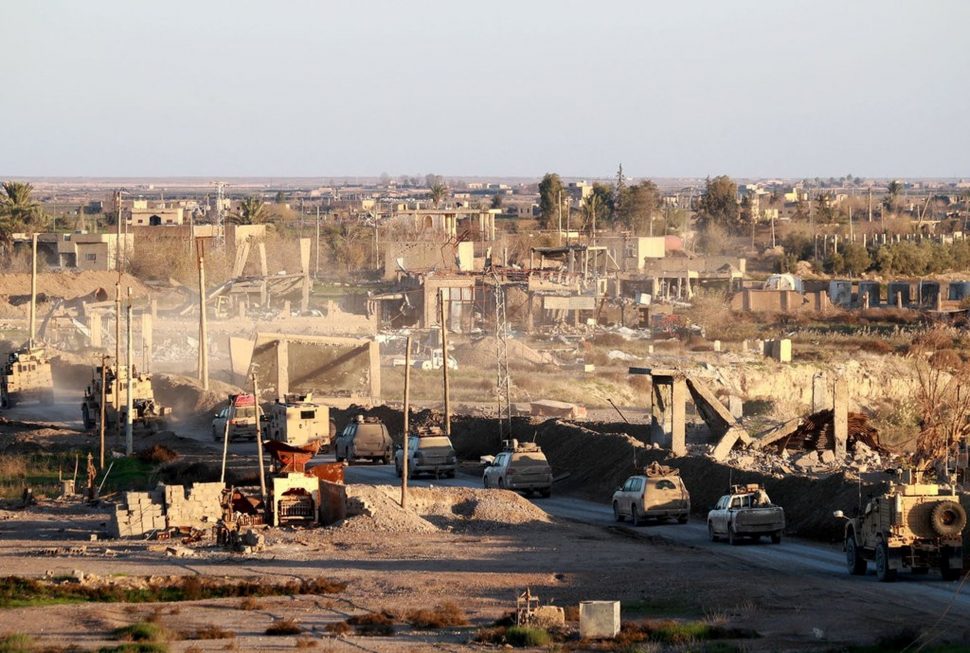(Trinidad Guardian) A 16-year-old Trinidad and Tobago national has been captured on the battlefield in Syria with fighters for the Islamic State, a report in the New York Times says.
The boy was initially thought to be an American but he was later confirmed to be a T&T teenager by US officials and the boy’s sister.
The report states that the teenager was taken from T&T to the war zone when he was 12 by his mother, who converted to Islam after becoming romantically involved with a radicalised man.
The article quoted the boy’s older sister (name omitted) in a phone interview. It said that after a four-year silence, she heard from them for the first time last month when her mother contacted her on Facebook Messenger and sent a series of audio recordings that said the two were alive and pleading for help. She said they were hiding somewhere in Syria.
“I need money to help us get out of here,” the mother (name omitted) said in one of the recordings she sent to her daughter, which was shared with The New York Times.
“If not me, your brother. He is innocent.”
The American-backed militia that announced the boy’s capture on Wednesday said he was among three American citizens apprehended in recent days in the battle zone fighting for the Islamic State, which is also called ISIS.
But Pentagon and State Department officials subsequently said only one of the three — Warren Christopher Clark, 34, a former substitute teacher from Texas — was an American.
The 16-year-old, who was erroneously identified in a news release from the American-backed militia as Soulay Noah Su, an American citizen, is actually (name omitted) from T&T, the boy’s sister said. She recognised him in a photo released by the militia, the Syrian Democratic Forces, she said.
A team led by Hany Farid, a Dartmouth College computer science professor, used facial identification software to compare the photo with images of the boy posted on social media and concluded with “high confidence” that the two were the same person.
According to the New York Times article, the sister, 23, said her mother and brother had fallen under the sway of a Trinidadian man who eventually persuaded them in 2014 to travel to the budding ISIS caliphate.
“Once they got to Syria, they told me that this guy took their documents and destroyed them, and said, ‘You are now going to stay here and die,’” the sister said.
In the audio recordings the mother sent to her daughter, she said, “Everyone wants to be blaming me, that I did bad things to my children. I just married a man.”
According to a database maintained by Simon Cottee, a University of Kent criminologist, the mother and son were part of a group of 10 people taken to Syria by a man (name omitted); also included were the man’s second wife, two of his daughters and three other boys, Cottee said.
After departing in September 2014, Hamlet appeared in ISIS propaganda, including in a photo spread in the terror group’s online magazine and in a video in which he is shown on his stomach, peering through the scope of a rifle.
“In my research on ISIS in Trinidad, one of my most striking findings is the block nature of the migrations to Syria and Iraq,” said Cottee, who is working on a book on jihadists from T&T, which has one of the world’s highest per capita rates of recruitment to ISIS. Cottee first noticed the captured teenager had a similar name to one in his database on Wednesday.
“It wasn’t just individuals going,” he told the New York Times.
“It was entire families looking to remake their lives in the so-called caliphate.”
Little is known about the mother and son’s time in Syria and the mother’s current whereabouts is unknown. The article notes that the boy’s Facebook timeline, which is sparse, reveals only a handful of photos that speak to possible military activity. Of greater interest to him appear to be posts about flashy hightop sneakers.
Because the boy was 12 when his mother took him to Syria, “He didn’t have any say or agency in the matter,” Cottee said.
“So he is a victim as much as a perpetrator in the Syrian jihad.”
The posts by his mother on her Facebook page, identified as authentic by her daughter, indicated more agency in her own radicalisation as well as a willingness to support her son’s exploration of military activities.
In a post in 2013, a year before they left for Syria, the boy’s mother congratulated him on his excellent grades. A year later, she liked a photo that her son had posted, presumably from Syria, of a mounted rifle. The following year, she liked a photo showing him in what appeared to be military fatigues. But in one of the final messages she sent to her daughter last month, the mother said she did not want her son to fight.
“Yesterday some people stopped him and they want him to go and fight,” she said in the audio message.
“I don’t want my child to be crippled.”
Editor’s note: The names of the boy, his mother and sister have been omitted as the boy is still a minor and is protected under T&T’s Children’s Act and cannot be identified regardless of the serious crime he is alleged to have committed. This act protects all persons under the age of 18.










